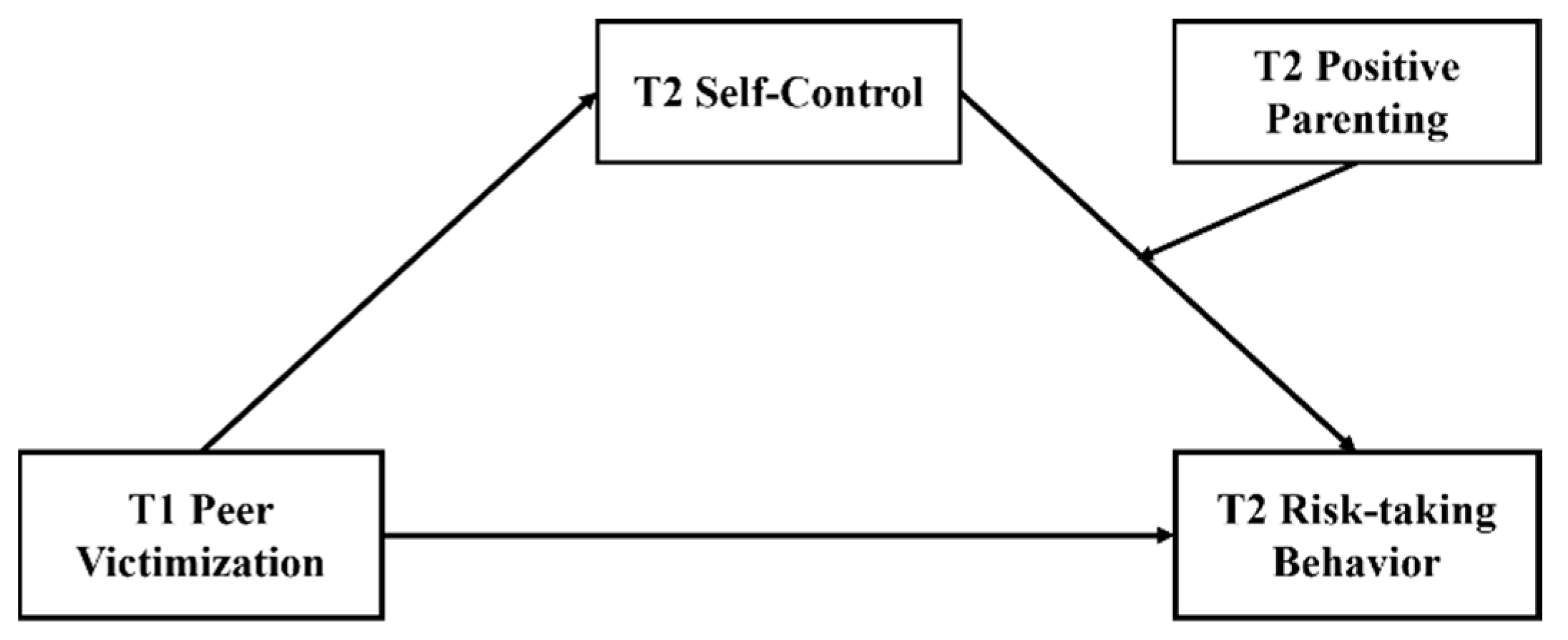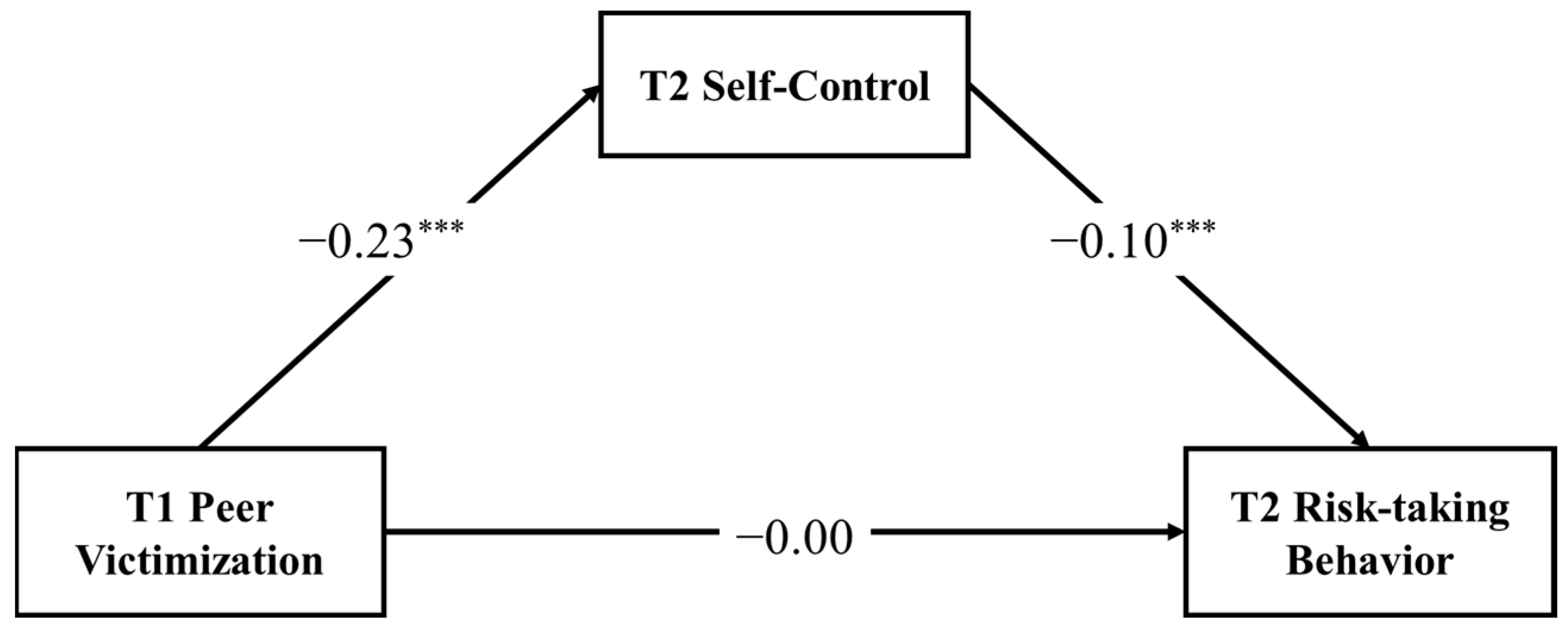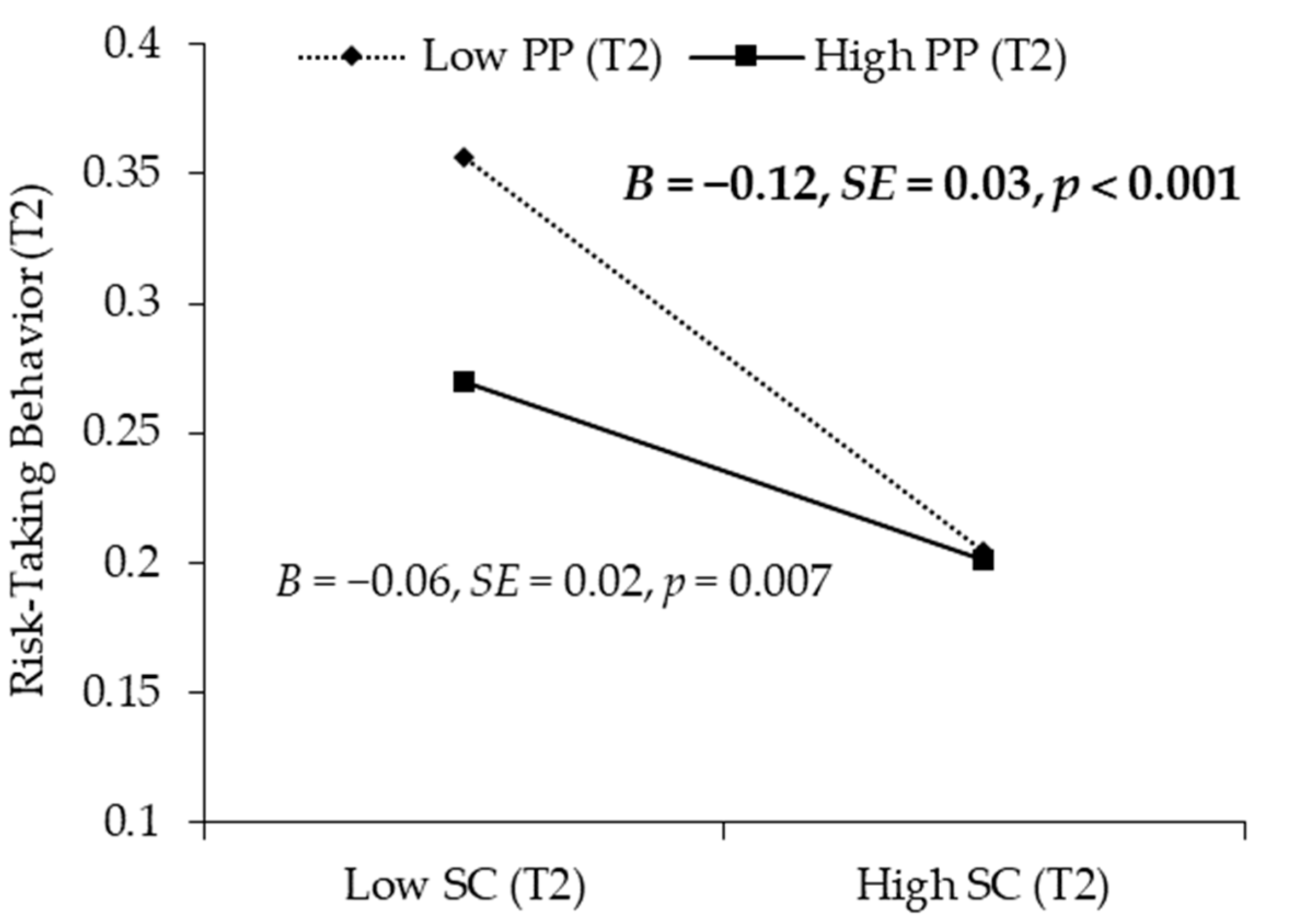The Association between Peer Victimization and Risk-Taking Behavior among Chinese Adolescents: Testing a Moderated Mediation Model
Abstract
1. Introduction
1.1. Mediating Role of Self-Control
1.2. Moderating Role of Positive Parenting
1.3. The Present Study
2. Materials and Methods
2.1. Participants
2.2. Measures
2.2.1. Peer Victimization at T1
2.2.2. Self-Control at T2
2.2.3. Positive Parenting at T2
2.2.4. Risk-Taking Behavior at T2
2.2.5. Control Variables
2.3. Statistical Analysis
3. Results
3.1. Descriptive Statistics
3.2. Mediating Effects of Self-Control
3.3. Moderating Effects of Positive Parenting
4. Discussion
5. Implications and Limitations
6. Conclusions
Author Contributions
Funding
Institutional Review Board Statement
Informed Consent Statement
Data Availability Statement
Conflicts of Interest
References
- Ben-Zur, H.; Zeidner, M. Threat to life and risk-taking behaviors: A review of empirical findings and explanatory models. Pers. Soc. Psychol. Rev. 2009, 13, 109–128. [Google Scholar] [CrossRef] [PubMed]
- Maciejewski, D.; Lauharatanahirun, N.; Herd, T.; Lee, J.; Deater-Deckard, K.; King-Casas, B.; Kim-Spoon, J. Neural cognitive control moderates the association between insular risk processing and risk-taking behaviors via perceived stress in adolescents. Dev. Cogn. Neurosci. 2018, 30, 150–158. [Google Scholar] [CrossRef]
- Dou, K.; Wang, L.; Cheng, D.; Li, Y.; Zhang, M. Longitudinal association between poor parental supervision and risk-taking behavior: The role of self-control and school climate. J. Adolesc. 2022, 94, 525–537. [Google Scholar] [CrossRef] [PubMed]
- Duell, N.; Steinberg, L.; Icenogle, G.; Chein, J.; Chaudhary, N.; Di Giunta, L.; Chang, L. Age patterns in risk taking across the world. J. Youth Adolesc. 2018, 47, 1052–1072. [Google Scholar] [CrossRef] [PubMed]
- Jiang, Y.; Yu, C.; Zhang, W.; Bao, Z.; Zhu, J. Peer Victimization and Substance Use in Early Adolescence: Influences of Deviant Peer Affiliation and Parental Knowledge. J. Child Fam. Stud. 2016, 25, 2130–2140. [Google Scholar] [CrossRef]
- Telzer, E.; Miernicki, M.; Rudolph, K. Chronic peer victimization heightens neural sensitivity to risk taking. Dev. Psychopathol. 2018, 30, 13–26. [Google Scholar] [CrossRef]
- Zhang, W.; Zhu, L. The influence of peers on adolescents’ risk-taking behavior and its mechanism. Adv. Psychol. Sci. 2021, 29, 1461–1471. [Google Scholar] [CrossRef]
- Ladd, G.W.; Ettekal, I.; Kochenderfer-Ladd, B. Peer victimization trajectories from kindergarten through high school: Differential pathways for children’s school engagement and achievement? J. Educ. Psychol. 2017, 109, 826–841. [Google Scholar] [CrossRef]
- Stroud, L.R.; Foster, E.; Papandonatos, G.D.; Handwerger, K.; Granger, D.A.; Kivlighan, K.T.; Niaura, R. Stress response and the adolescent transition: Performance versus peer rejection stressors. Dev. Psychopathol. 2009, 21, 47–68. [Google Scholar] [CrossRef]
- Zhai, B.; Li, D.; Jia, J.; Liu, Y.; Sun, W.; Wang, Y. Peer victimization and problematic internet use in adolescents: The mediating role of deviant peer affiliation and the moderating role of family functioning. Addict. Behav. 2019, 96, 43–49. [Google Scholar] [CrossRef]
- Hirschi, T. Causes of Delinquency; University of California Press: Berkeley, CA, USA, 1969. [Google Scholar]
- Baumeister, R.F.; Vohs, K.D.; Tice, D.M. The strength model of self-control. Curr. Dir. Psychol. Sci. 2007, 16, 351–355. [Google Scholar] [CrossRef]
- Li, J.B.; Willems, Y.E.; Stok, F.M.; Dekovic, M.; Bartels, M.; Finkenauer, C. Parenting and self-control across early to late adolescence: A three-level meta-analysis. Perspect. Psychol. Sci. 2019, 14, 967–1005. [Google Scholar] [CrossRef] [PubMed]
- Bandura, A. Social Foundations of Thoughts and Action: A Social Cognitive Theory; Prentice-Hall: Englewood Cliffs, NJ, USA, 1986. [Google Scholar]
- Chui, W.H.; Chan, H.C. Self–control, school bullying perpetration, and victimization among Macanese adolescents. J. Child. Fam. Stud. 2015, 24, 1751–1761. [Google Scholar] [CrossRef]
- Gao, L.; Li, S.; Li, G.; Yang, J.; Wang, X. The effect of adolescents’ friendship jealousy on aggression: The chain mediating role of self-esteem and self-control. Chinese J. Clin. Psychol. 2022, 30, 425–433. [Google Scholar] [CrossRef]
- Yu, B.; Yue, G.; Liu, H. The strength model of self-control. Adv. Psychol. Sci. 2013, 21, 1272–1282. [Google Scholar] [CrossRef]
- Yang, L.; Shen, Y.; Ma, S. The Influence of Temperament, Teacher Expectation and Peer Acceptance on Early Children’s Self-Control. J. Psychol. Sci. 2012, 35, 1410–1415. [Google Scholar] [CrossRef]
- Wang, C.; Zhao, J.; Qin, H. Influence of peer victimization on adolescent suicidal ideation: Chain mediating effect analysis. China J. Health Psychol. 2022, 30, 291–295. [Google Scholar] [CrossRef]
- Sun, Y.; Li, J.; Oktaufik, M.; Vazsonyi, A. Parental Attachment and Externalizing Behaviors among Chinese Adolescents: The Mediating Role of Self-Control. J. Child Fam. Stud. 2022, 31, 923–933. [Google Scholar] [CrossRef]
- Van der Ende, J.; Verhulst, F.C.; Tiemeier, H. The bidirectional pathways between internalizing and externalizing problems and academic performance from 6 to 18 years. Dev. Psychopathol. 2016, 28, 855–867. [Google Scholar] [CrossRef]
- Holmes, C.; Brieant, A.; Kahn, R. Deater-Deckard, K.; Kim-Spoon, J. Structural Home Environment Effects on Developmental Trajectories of Self-Control and Adolescent Risk Taking. J. Youth Adolesc. 2019, 48, 43–55. [Google Scholar] [CrossRef]
- Kahn, R.; Holmes, C.; Farley, J.; Kim-Spoon, J. Delay discounting mediates parent–adolescent relationship quality and risky sexual behavior for low self-control adolescents. J. Youth Adolesc. 2015, 44, 1674–1687. [Google Scholar] [CrossRef] [PubMed]
- Cummings, M.; Davies, P.; Campbell, S. Developmental Psychopathology and Family Process: Theory, Research, and Clinical Implications; The Guilford Press: New York, NY, USA, 2002. [Google Scholar] [CrossRef]
- Chronis, A.M.; Lahey, B.B.; Pelham, W.E.; Williams, S.H.; Baumann, B.L.; Kipp, H.; Jones, H.A.; Rathouz, P.J. Maternal depression and early positive parenting predict future conduct problems in young children with attention-deficit/hyperactivity disorder. Dev. Psychol. 2007, 43, 70–82. [Google Scholar] [CrossRef] [PubMed]
- Niu, G.; Yao, L.; Wu, L.; Tian, Y.; Xu, L.; Sun, X. Parental phubbing and adolescent problematic mobile phone use: The role of parent-child relationship and self-control. Child. Youth Serv. Rev. 2020, 116, 105247. [Google Scholar] [CrossRef]
- Wang, Y.; Tian, L.; Huebner, E. Parental control and Chinese adolescent smoking and drinking: The mediating role of refusal self-efficacy and the moderating role of sensation seeking. Child. Youth Serv. Rev. 2019, 102, 63–72. [Google Scholar] [CrossRef]
- Potter, M.; Font, S. Parenting influences on adolescent sexual risk-taking: Differences by child welfare placement status. Child. Youth Serv. Rev. 2019, 96, 134–144. [Google Scholar] [CrossRef] [PubMed]
- Wang, M. Harsh parenting and adolescent aggression: Adolescents’ effortful control as the mediator and parental warmth as the moderator. Child Abuse Negl. 2019, 94, 104021. [Google Scholar] [CrossRef]
- Nicholson, J.V.; Chen, Y.; Huang, C.C. Children’s exposure to intimate partner violence and peer bullying victimization. Child. Youth Serv. Rev. 2018, 91, 439–446. [Google Scholar] [CrossRef]
- Dou, K.; Feng, X.; Wang, L.; Li, J. Longitudinal association between parental involvement and internet gaming disorder among Chinese adolescents: Consideration of future consequences as a mediator and peer victimization as a moderator. J. Behave. Addict. 2022, 11, 820–830. [Google Scholar] [CrossRef]
- Tangney, J.P.; Baumeister, R.F.; Boone, A.L. High self-control predicts good adjustment, less pathology, better grades, and interpersonal success. J. Pers. 2004, 72, 271–324. [Google Scholar] [CrossRef]
- Elgar, F.J.; Waschbusch, D.A.; Dadds, M.R.; Sigvaldason, N. Development and validation of a short form of the Alabama parenting questionnaire. J. Child Fam. Stud. 2007, 16, 243–259. [Google Scholar] [CrossRef]
- Jiang, S.; Jiang, C.; Ren, Q.; Wang, L. Cyber victimization and psychological well-being among Chinese adolescents: Mediating role of basic psychological needs satisfaction and moderating role of positive parenting. Child. Youth Serv. Rev. 2021, 130, 106248. [Google Scholar] [CrossRef]
- Gullone, E.; Moore, S.; Moss, S.; Boyd, C. The adolescent risk-taking questionnaire: Development and psychometric evaluation. J. Adolescent Res. 2000, 15, 231–250. [Google Scholar] [CrossRef]
- Muthén, L.K.; Muthén, B.O. Mplus User’s Guide, 1998–2012, 7th ed.; Muthén & Muthén: Los Angeles, CA, USA, 1998. [Google Scholar]
- Preacher, K.J.; Hayes, A.F. Asymptotic and resampling strategies for assessing and comparing indirect effects in multiple mediator models. Behav. Res. Methods 2008, 40, 879–891. [Google Scholar] [CrossRef] [PubMed]
- Acock, A.C. Working with missing values. J. Marriage Fam. 2005, 67, 1012–1028. [Google Scholar] [CrossRef]
- Nie, Y.; Li, J.; Vazsonyi, A. Self-control mediates the associations between parental attachment and prosocial behavior among Chinese adolescents. Pers. Indiv. Differ. 2016, 96, 36–39. [Google Scholar] [CrossRef]
- Liao, Y.; Chen, J.; Zhang, Y.; Peng, C. The reciprocal relationship between peer victimization and internalizing problems in children and adolescents: A meta-analysis of longitudinal studies. Acta. Psychol. Sin. 2022, 54, 828–849. [Google Scholar] [CrossRef]
- Leidy, M.S.; Guerra, N.G.; Toro, R.I. Positive parenting, family cohesion, and child social competence among immigrant Latino families. J. Fam. Psychol. 2010, 24, 252–260. [Google Scholar] [CrossRef]
- Shachar, K.; Ronen-Rosenbaum, T.; Rosenbaum, M.; Orkibi, H.; Hamama, L. Reducing child aggression through sports intervention: The role of self-control skills and emotions. Child. Youth Serv. Rev. 2016, 71, 241–249. [Google Scholar] [CrossRef]
- Tang, Y.; Tang, R.; Gross, J. Promoting psychological well-being through an evidence-based mindfulness training program. Front. Hum. Neurosci. 2019, 13, 237. [Google Scholar] [CrossRef]



| 1 | 2 | 3 | 4 | 5 | 6 | 7 | 8 | 9 | 10 | |
|---|---|---|---|---|---|---|---|---|---|---|
| Covariates | ||||||||||
| 1. Adolescent age at T1 | - | |||||||||
| 2. Adolescent gender | −0.03 | - | ||||||||
| 3. Parent age at T1 | 0.38 ** | −0.06 | - | |||||||
| 4. Parent gender | −0.04 | 0.06 | −0.20 ** | - | ||||||
| 5. Father’s education | −0.07 | 0.02 | 0.02 | 0.04 | - | |||||
| 6. Mother’s education | −0.08 | 0.02 | −0.07 | 0.13 ** | 0.44 *** | - | ||||
| Key variables | ||||||||||
| 7. T1 Peer Victimization | 0.01 | −0.11 * | 0.02 | −0.01 | 0.09 * | −0.04 | - | |||
| 8. T2 Self-Control | −0.25 *** | 0.01 | −0.09 | 0.03 | −0.05 | 0.01 | −0.21 *** | - | ||
| 9. T2 Positive Parenting | −0.04 | −0.05 | −0.01 | 0.01 | 0.06 | 0.12 ** | −0.06 | 0.21 *** | - | |
| 10. T2 Risk-Taking Behavior | 0.08 | −0.15 ** | −0.04 | −0.05 | 0.01 | −0.01 | 0.06 | −0.26 *** | −0.13 ** | - |
| M | 14.44 | 1.50 | 41.61 | 1.50 | 2.11 | 1.94 | 0.67 | 3.22 | 3.24 | 0.17 |
| SD | 1.55 | 0.50 | 4.34 | 0.50 | 0.53 | 0.57 | 0.54 | 0.61 | 0.98 | 0.22 |
| Min | 11.59 | 1.00 | 35.00 | 1.00 | 1.00 | 1.00 | 0.00 | 1.31 | 1.00 | 0.00 |
| Max | 18.85 | 2.00 | 56.00 | 2.00 | 4.00 | 4.00 | 4.00 | 4.92 | 5.00 | 1.64 |
| Direct and Indirect Effects | Bias-Corrected Bootstrapped Estimates for the Effects | |||
|---|---|---|---|---|
| Unstandardized | SE | 95% CI | Standardized | |
| Direct Pathway | ||||
| T1 Peer victimization → T2 Risk-taking behavior | −0.00 | 0.02 | (−0.039, 0.034) | −0.01 |
| Indirect Pathway | ||||
| T1 Peer victimization → T2 Self-control → T2 Risk-taking behavior | 0.02 | 0.02 | (0.025, 0.087) | 0.05 |
| T2 Self-Control (R2 = 0.11) | T2 Risk-Taking Behavior (R2 = 0.2) | |||||
|---|---|---|---|---|---|---|
| B | SE | 95% CI | B | SE | 95% CI | |
| Covariates | ||||||
| Adolescent age at T1 | −0.10 | 0.02 | (−0.136, −0.067) | 0.00 | 0.00 | (−0.014, 0.013) |
| Adolescent gender | −0.01 | 0.06 | (−0.123, 0.098) | −0.08 | 0.02 | (−0.120, −0.038) |
| Father’s level of education | −0.05 | 0.05 | (−0.172, 0.063) | 0.00 | 0.02 | (−0.045, 0.050) |
| Mother’s level of education | −0.00 | 0.05 | (−0.093, 0.093) | 0.01 | 0.02 | (−0.035, 0.048) |
| Study variables | ||||||
| T1 Peer victimization | −0.22 | 0.06 | (−0.336, −0.114) | −0.01 | 0.02 | (−0.046, 0.033) |
| T2 Self-control | −0.09 | 0.02 | (−0.131, −0.051) | |||
| T2 Positive parenting | −0.02 | 0.01 | (−0.044, −0.003) | |||
| T2 Self-control × T2 Positive parenting | 0.04 | 0.02 | (0.000, 0.075) | |||
| Levels of T2 Positive Parenting | Indirect Effect | SE | 95% CI |
|---|---|---|---|
| Low | 0.03 | 0.01 | (0.012, 0.053) |
| Med | 0.04 | 0.01 | (0.009, 0.038) |
| High | 0.01 | 0.01 | (0.003, 0.028) |
| Diff = High − Low | −0.02 | 0.01 | (−0.038, −0.001) |
Publisher’s Note: MDPI stays neutral with regard to jurisdictional claims in published maps and institutional affiliations. |
© 2022 by the authors. Licensee MDPI, Basel, Switzerland. This article is an open access article distributed under the terms and conditions of the Creative Commons Attribution (CC BY) license (https://creativecommons.org/licenses/by/4.0/).
Share and Cite
Nie, Y.; Wang, G.; Chen, P.; Wang, L.; Dou, K. The Association between Peer Victimization and Risk-Taking Behavior among Chinese Adolescents: Testing a Moderated Mediation Model. Int. J. Environ. Res. Public Health 2022, 19, 14198. https://doi.org/10.3390/ijerph192114198
Nie Y, Wang G, Chen P, Wang L, Dou K. The Association between Peer Victimization and Risk-Taking Behavior among Chinese Adolescents: Testing a Moderated Mediation Model. International Journal of Environmental Research and Public Health. 2022; 19(21):14198. https://doi.org/10.3390/ijerph192114198
Chicago/Turabian StyleNie, Yangang, Guodong Wang, Pei Chen, Linxin Wang, and Kai Dou. 2022. "The Association between Peer Victimization and Risk-Taking Behavior among Chinese Adolescents: Testing a Moderated Mediation Model" International Journal of Environmental Research and Public Health 19, no. 21: 14198. https://doi.org/10.3390/ijerph192114198
APA StyleNie, Y., Wang, G., Chen, P., Wang, L., & Dou, K. (2022). The Association between Peer Victimization and Risk-Taking Behavior among Chinese Adolescents: Testing a Moderated Mediation Model. International Journal of Environmental Research and Public Health, 19(21), 14198. https://doi.org/10.3390/ijerph192114198







